Review: Desert X has a great big wall. Beyond that, this art biennial feels thin
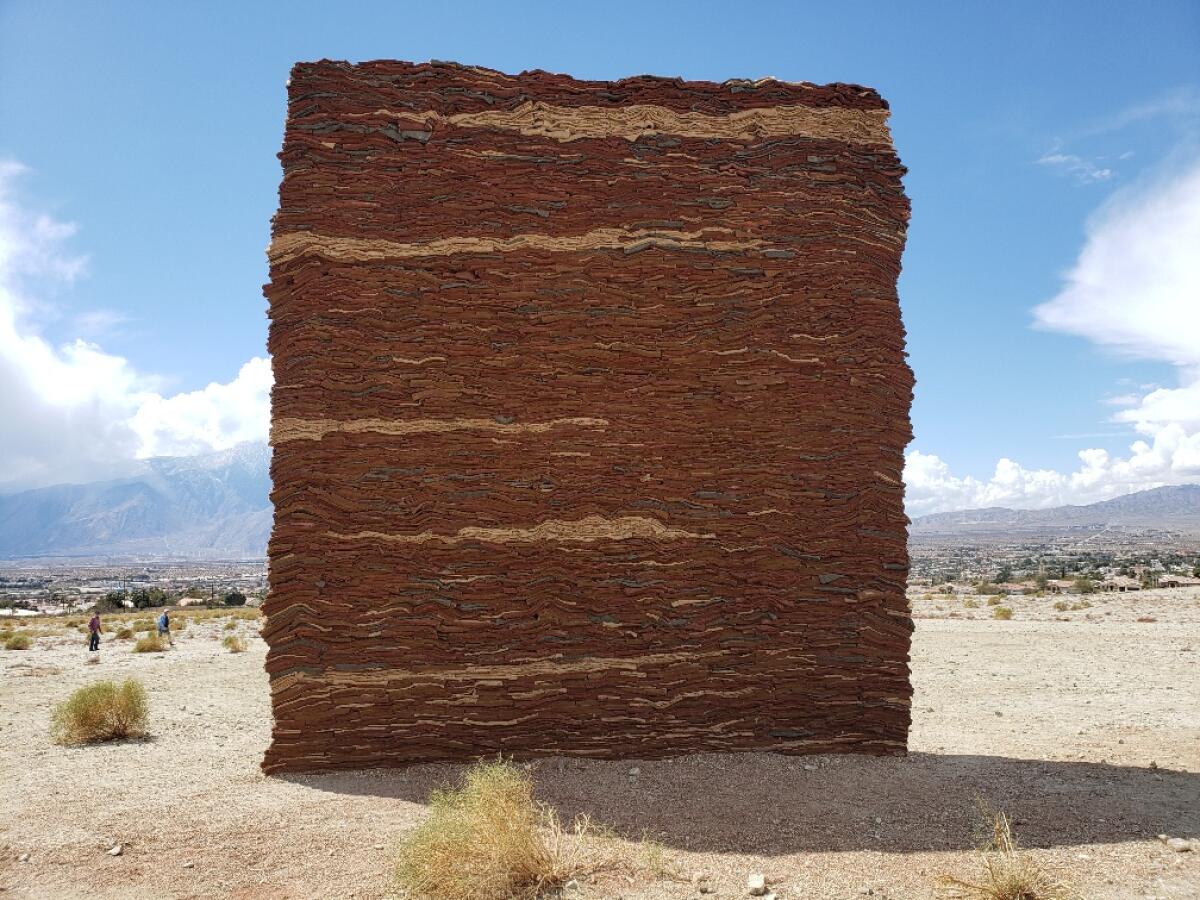
- Share via
Palm Springs — High on a hill at the edge of the dusty town of Desert Hot Springs, about a 20-minute drive due north of Palm Springs City Hall, stands a monumental sculpture by Saudi artist Zahrah Alghamdi. It’s one of 13 commissioned works for Desert X 2021, eight of which went on view Friday around the Coachella Valley when the third installment of the biennial exhibition opened.
Overall, the show feels thin. Alghamdi’s sculpture, “What Lies Behind the Walls,” is an enthralling exception.
A wide monolith, the sculpture is configured as a barricade 25 or more feet high. Materials used to construct the thick, free-standing wall are visually ambiguous — stacks of what appears to be turf, insulation or folded carpet infused with dirt and cement.
The organic stacks create horizontal strata in tinted shades of tan, umber and rusty brown, as if the wall is a physical record of a span of geological time sliced and extracted from within the earth. The scale is perfectly calibrated to a rugged, sparsely populated landscape site that could easily swallow up a lesser sculpture, while remaining imposing but not overwhelming to an individual viewer. The desert floor below, backed by mountains that ring the valley, spreads far into the distance.
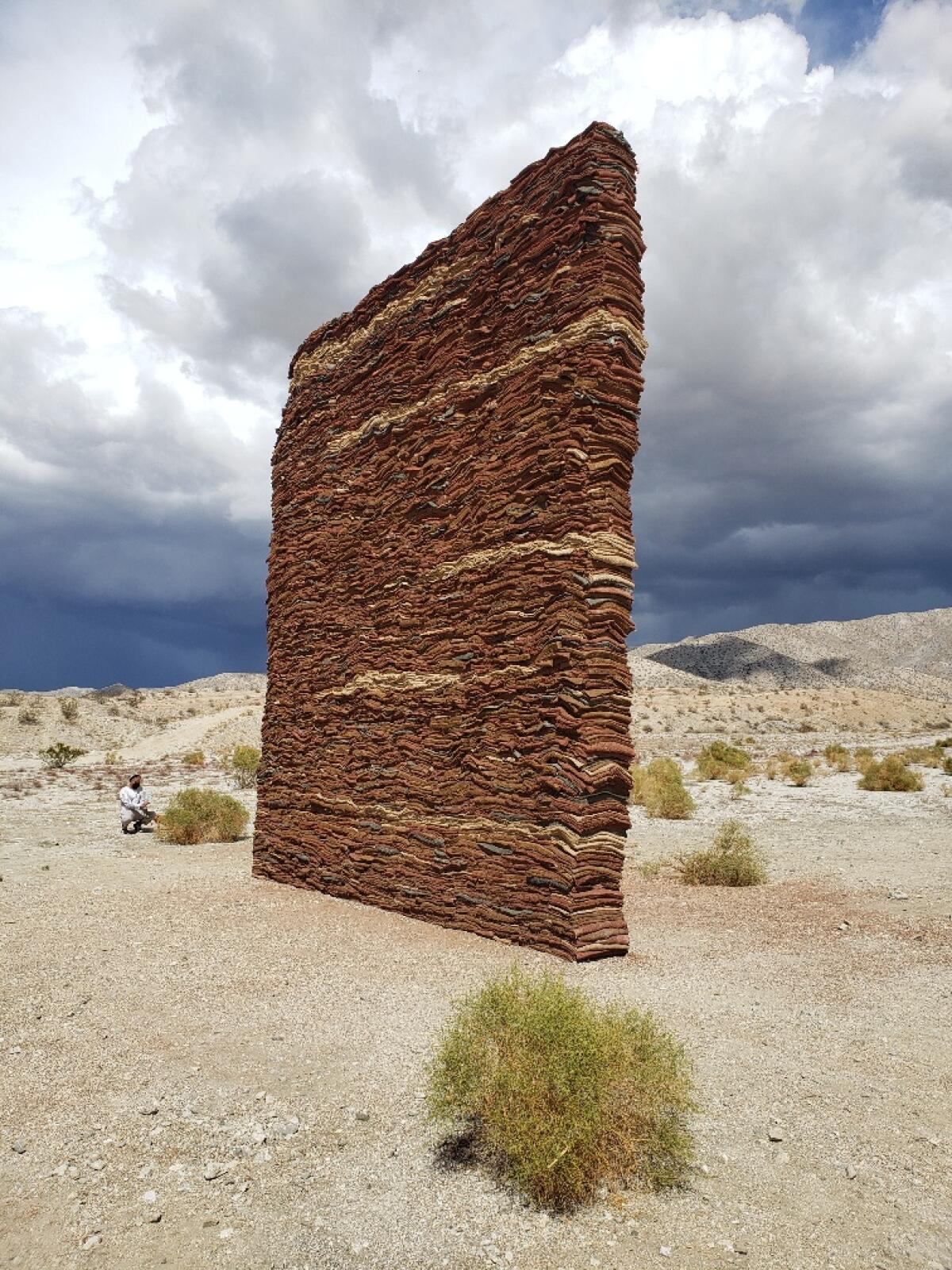
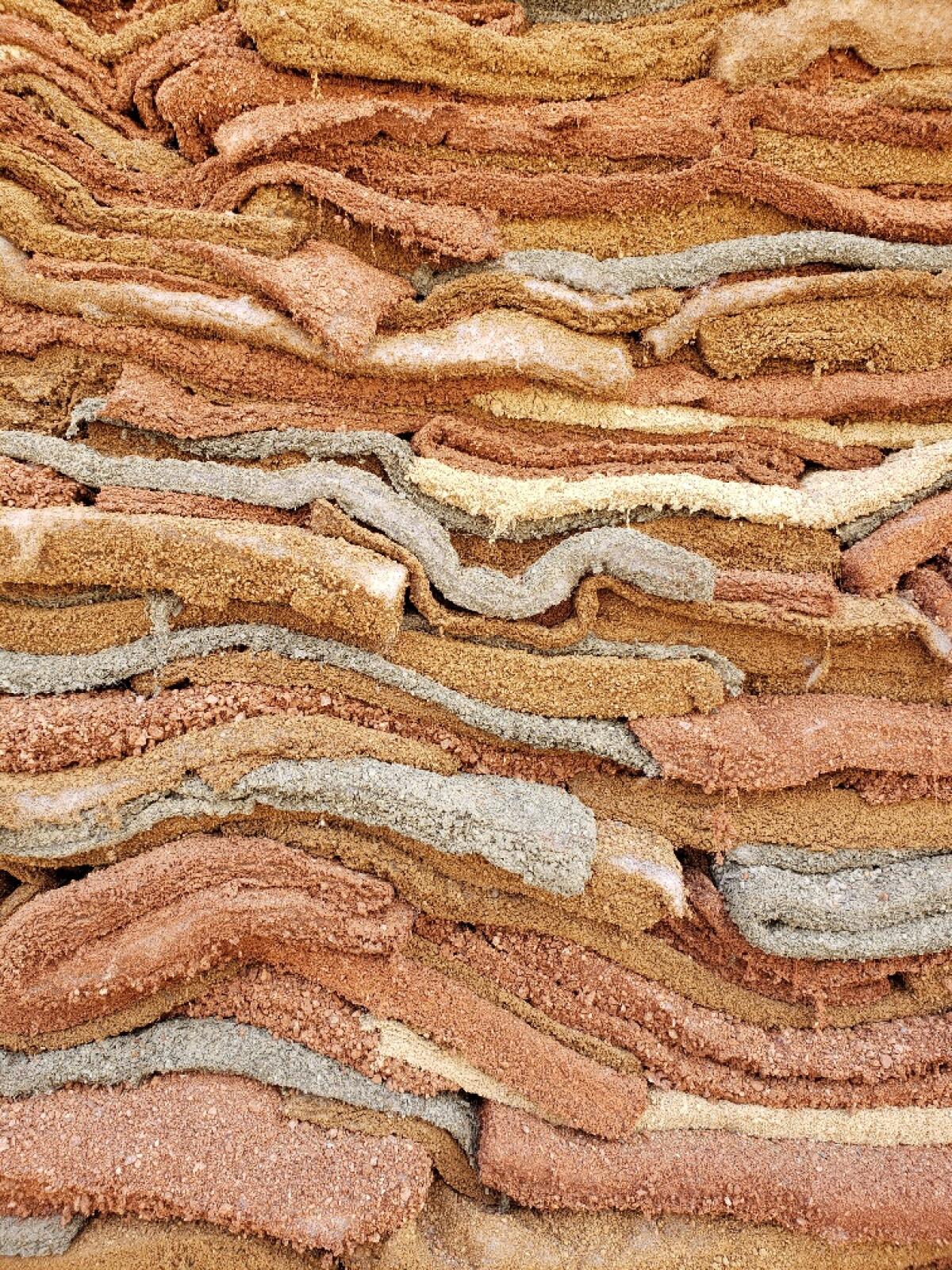
The wall faces northeast and southwest. A viewer is positioned as if to split the difference between facing Mecca to the east, birthplace of the artist’s Islamic faith, and the borderlands to the south, site of the noxious wall erected between the United States and Mexico. Standing before the monolith, your sense of secure orientation within the diffused desert landscape is subtly but firmly heightened.
The sculpture’s material allusions to carpet, insulation and turf suddenly seem a fusion of prayer rugs, home and the landscape underfoot, out of which a daunting but not insurmountable obstacle rises. “What Lies Behind the Walls” is a hope and a promise of spiritual salvation and human freedom.
Alghamdi’s philosophically acute sculpture is by far the most compelling work in DX21 — reason enough on its own to see the exhibition. There are not many more.
Most notable are works by Serge Attukwei Clottey and Ghada Amer.
On a green community center lawn, Attukwei Clottey draped a pair of monumental Minimalist cubes with a textile made from small, square pieces of bright yellow plastic laboriously wired together by hand. The technique recalls the work of fellow Ghanaian-born artist El Anatsui; rather than his bottle caps and shiny bits of commercial packaging, however, the drapery in Attukwei Clottey’s “The Wishing Well” is pieced from fragments of common plastic water containers.
As an artistic form, the machine-geometry of a classic Minimalist cube has long signaled the heavy industrialization of the modern world — which ravaged Africa, contributing to the water crises that today plague Ghana. Securing the resource for survival requires relentless daily labor.
That’s what all those yellow water containers are for. Bringing the local desert into the endurance narrative, Attukwei Clottey spread a puddle-shaped sheet on the ground that links the two cubes.
Set in another lovely garden, Amer’s “Women’s Qualities” is partly tongue-in-cheek, supposedly identifying essential human attributes according to gender. And partly it’s a savvy dismantling of cultural stereotypes often ascribed to nature.
A ring of knee-high steel planters in the shape of letters spells out supposedly feminine adjectives such as “resilient” and “nurturing.” The plants within are keyed to the word’s meaning — tough barrel cactus for the former, fragrant sage for the latter.
The text is composed in a circle that evokes the central core imagery feminist artists once offered as a counterpoint to the rising phallic monuments of patriarchy. With subtlety and wit, Amer’s garden sculpture conjures Eve’s biblical banishment, while transforming a big, manicured lawn into a sly abstraction of a putting green at a desert golf course.
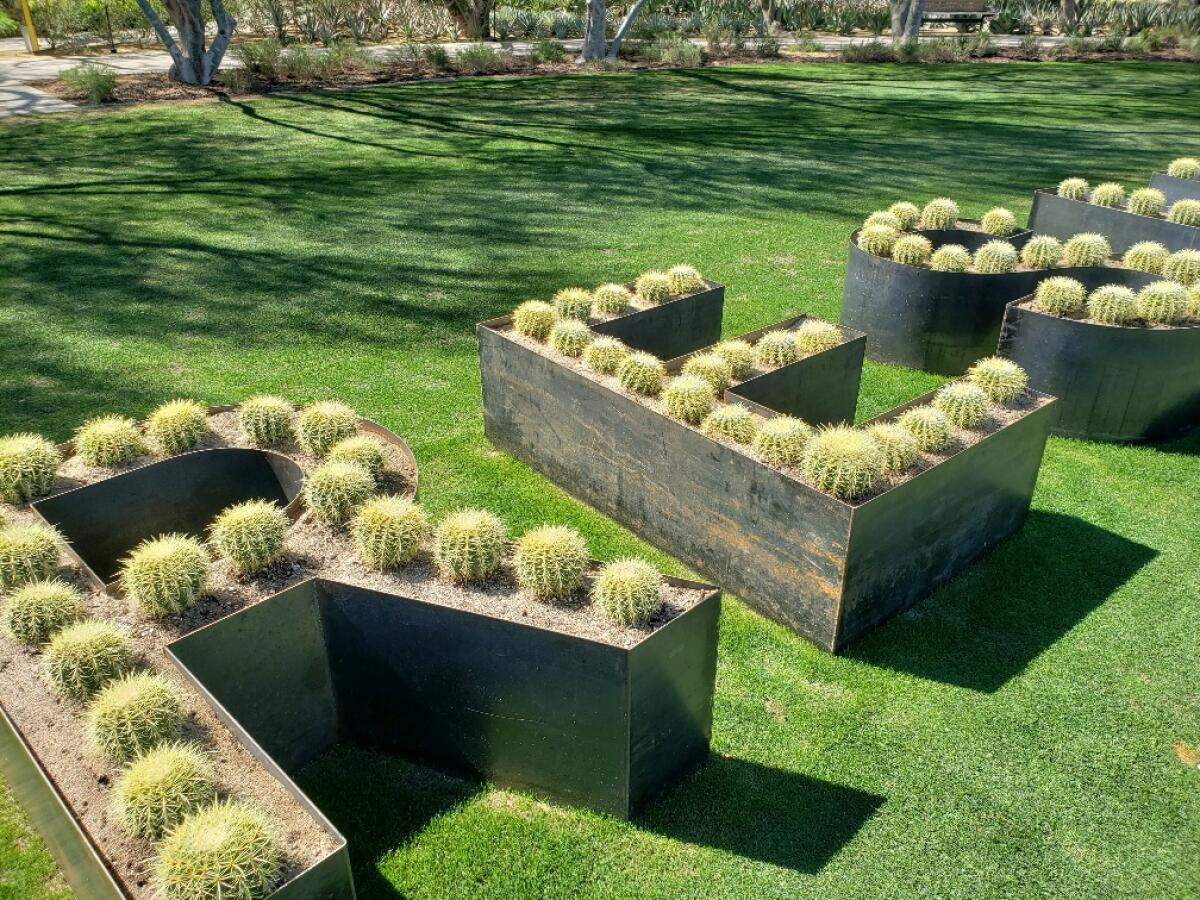
The show, organized by Desert X artistic director Neville Wakefield and guest curator César García-Alvarez, is one-third smaller than the prior outing two years ago. Many of the artists — including Attukwei Clottey, Felipe Baeza, Oscar Murillo, Vivian Suter and Eduardo Sarabia — have shown at the Mistake Room, García-Alvarez’s L.A. nonprofit exhibition space.
Kim Stringfellow, the only local participant (she works in nearby Joshua Tree), has re-created a small, humble “jackrabbit cabin” of the remote type built in the last century by desert homesteaders. The bland if tidy little shack is a kind of alternative Midcentury Modern architecture, for which suburbanized Palm Springs is now famous. The front windows of one of those latter buildings — a recently defunct liquor store — is the site for a large group of dull abstract paintings by Guatemala-based Suter.
In the foothills near the Palm Springs Visitors Center, Nicholas Galanin, a Tlingit and Unangax̂ artist from Alaska, has mimicked L.A.’s famous Hollywood Sign at smaller scale — but with a notable difference. Galanin’s “Never Forget” references the colonization of ancestral Cahuilla territory.
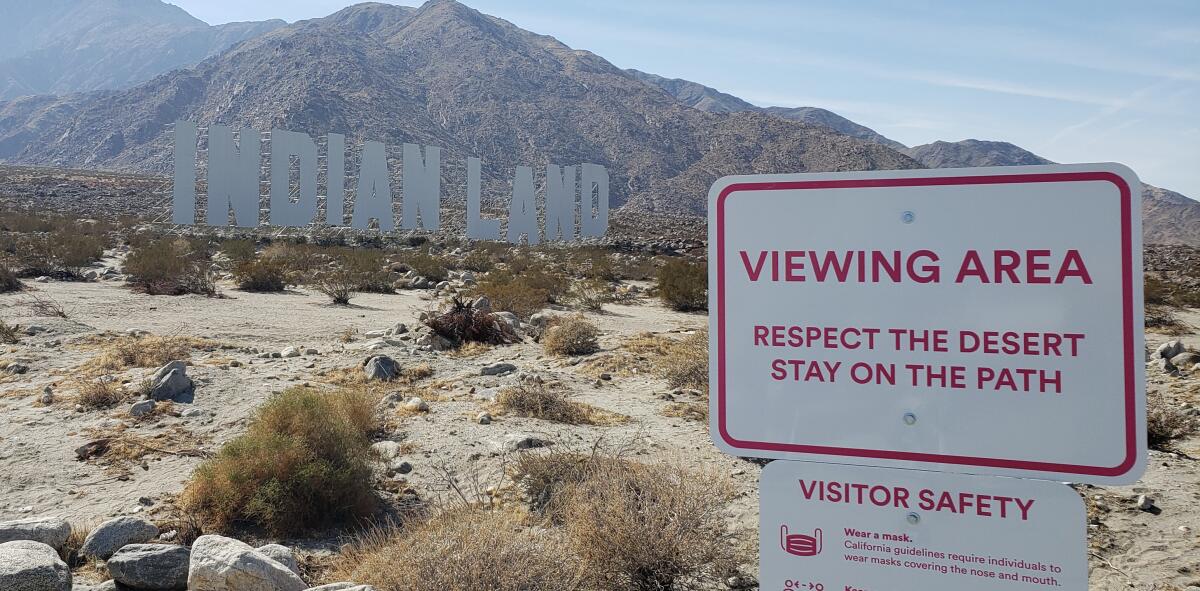
The undulating Pop installation of the word “Indianland” acknowledges the Hollywood Sign’s original form, erected as a real estate gimmick to sell white homeowners on a 1923 hillside development that featured racially restricted covenants enforcing Jim Crow segregation. It’s the show’s most Instagram-ready work, which is both a strength and a weakness: strong because the virtual image will travel far and wide, weak because seeing it reproduced on a cellphone screen isn’t much different from encountering the analog object at the site.
A related, somewhat reversed issue hampers Xaviera Simmons’ string of billboards along Gene Autry Trail, a busy thoroughfare between the city and Interstate 10. Her image-and-text articulations of the pressing topic of Black reparations and redistribution of wealth are smart. But billboards aren’t designed for the paragraph-length typography found on several of them, which simply cannot be read at 55 mph.
The most bracing feature of Simmons’ work is its marvelously rebellious, confrontational title: “Because You Know Ultimately We Will Band a Militia.” The double-edged sentiment, with its Nat Turner-style evocation of slavery’s horrors, speaks of Black determination and white fear, both going back centuries.
That five of Desert X’s 13 works were not ready for opening day is disappointing. (Some were planned to open in April, one was unfinished and a Judy Chicago performance has been canceled for lack of a suitable venue.) In the most egregious case, visitors parked by the side of a remote road to climb a steep, quarter-mile path up a hill, only to discover at the top a construction crew assembling Alicja Kwade’s sculpture of steel beams holding chunks of white marble aloft.
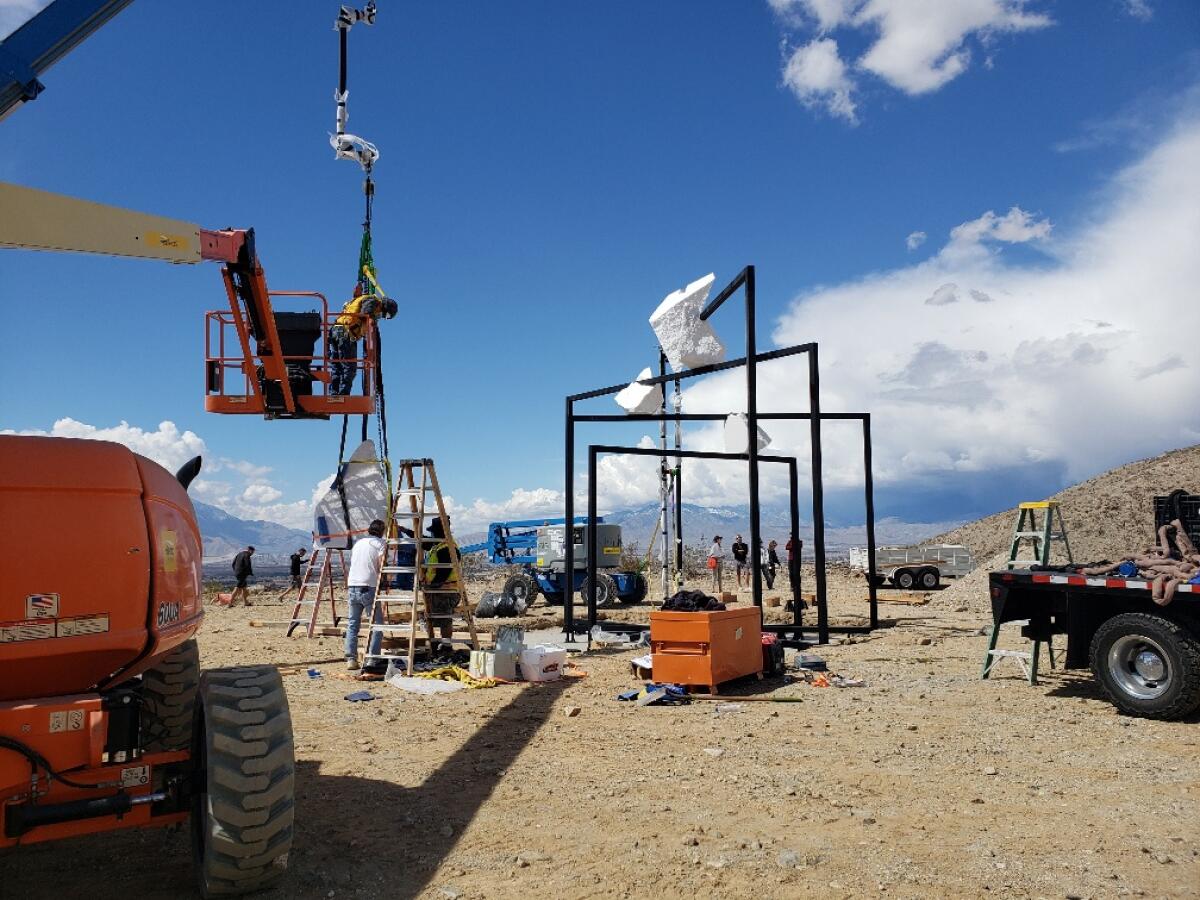
What, we couldn’t have been warned at the bottom of the huffing-and-puffing hill that all we’d see at the top is a busy construction site?
DX21 is thankfully more compact than the 2019 edition, which, sprawling all the way to the Salton Sea, was tough to take in for the cultural tourists to whom the show is pitched. As an exhibition, it did face two big disasters — one self-inflicted, the other beyond its control.
First, the show’s organizers encountered fallout from their terrible decision to partner for a similar event last year in Saudi Arabia. The desert nation is an absolute monarchy that criminalizes free speech and, in the case of Desert X AlUla patron Mohammed Bin Salman, will murder a dissenting voice to maintain its own authoritarian power. (Sculptor Zahrah Alghamdi was in the AlUla exhibition.)
It started as a promising California art biennial. It’s now a partnership with a government linked to human rights abuses and the killing of a journalist.
Second, barely a week after the Saudi fiasco ended, California went into quarantine lockdown to fight the COVID-19 pandemic. Planning and execution for the current edition were interrupted.
With pandemic restrictions slowly being lifted, the urge to be out and about is strong. (Some works require advanced ticketing.) A few more DX21 works will be installed next month, but it’s too bad there isn’t more worth seeing now.
More to Read
The biggest entertainment stories
Get our big stories about Hollywood, film, television, music, arts, culture and more right in your inbox as soon as they publish.
You may occasionally receive promotional content from the Los Angeles Times.











